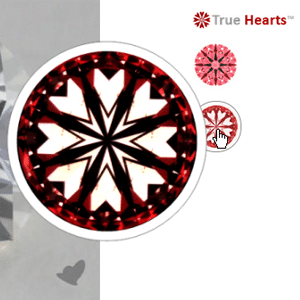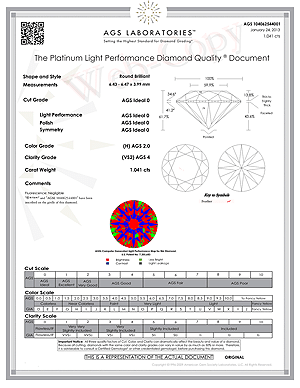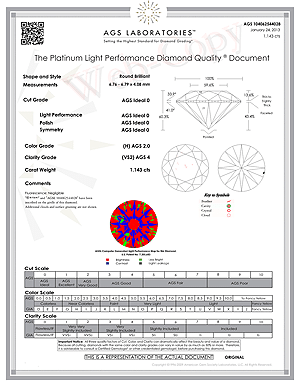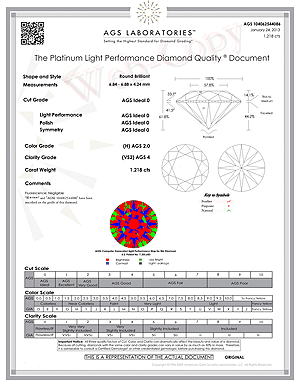Hi Todd, a friend of mine recommended your diamond concierge service after you helped him buy a pair of diamond earrings for a Christmas present. I’m in the market for a diamond engagement ring and am trying to decide between several diamonds which I found on James Allen and Ritani. I noticed that each vendor seems to have their own classification of ideal cut diamond, which I assume to be the best they have to offer, so I limited my search to Ritani Reserve Ideal and James Allen True Hearts, 1.0 – 1.2 carats, H color, VS2 clarity, with an overall cut grade of AGS Ideal which you seem to prefer over GIA Excellent. Can you help me select the best option? Thanks! — David P.
James Allen True Hearts Diamond Review:

The term “ASET” is an abbreviation for Angular Spectrum Evaluation Technology which is proprietary to the American Gem Society Laboratory (AGSL) and provides insight into the different levels of brightness created by the combination of proportions and the optical symmetry of the diamond. ASET provides an insight which is invaluable to the diamond selection process as you will see by what is revealed in the Reviews of Ritani Reserve Ideal cut diamonds provided below. I don’t know why James Allen would decide not to opt for the AGSL report format which features an ASET image for a diamond which scored zero for light performance, but I wish they had ordered that version of the report for this diamond.
Working with the information that is available on this diamond, we know that the diamond has an overall cut grade of AGS Ideal-0 and that it scored zero for light performance, polish, symmetry and proportions, as indicated in the upper right corner of the flap featured on the diamond grading report. The diamond has a total depth of 61.6% and a table diameter of 56.2% with a crown angle of 34.9 degrees that is offset by a pavilion angle of 40.9 degrees with a thin to medium, faceted girdle and a pointed culet.
This particular range of proportions is recognized as being the center or “sweet spot” and is well known for producing diamonds which exhibit a high volume of light return. My guess is that this diamond will face up nice and bright and exhibit the full spectrum of sparkle that you’re probably hoping for… the primary inclusions consist of diamond crystals and groups of pinpoints size diamond crystals called clouds.
Ritani Reserve Ideal Diamond Review: AGS #104062544001

In addition to not being thrilled with the look of the ASET image for this Ritani Reserve ideal cut diamond, I think that a pavilion angle of 41.2 degrees is too steep and results in a lesser volume of light return than is provided by my preferred range which is between 40.6 – 40.9 degrees, as stated within the article One Minute Diamond Buying Guide.
Combine the slightly steep pavilion angle of 41.2 degrees with the larger table diameter of 59.9% and the reality is that this diamond is sitting right on the outer edge of the parameters for the zero ideal cut proportions rating and I think that you could do better.
Ritani Reserve Ideal Diamond Review: AGSL 104062544028

A cavity is exactly what it sounds like, a small hole located in the surface of the diamond and if you look really close you’ll see that this one also has a feather extending out from it, which is a small fracture and since this is located along the girdle edge of the diamond, this diamond does not meet my selection criteria for proportions or inclusions despite the overall cut grade of AGS Ideal-0.
Ritani Reserve Ideal Diamond Review: AGSL 104062544086

I’m guessing that this is due to the fact that the pavilion angle is extremely steep at 41.5 degrees, but it might actually work well with the crown angle which is very shallow at 33.7 degrees. Generally speaking, you either want everything in the middle of the range, or you want to combine steep with shallow or vice versa, but the measurements of this diamond actually hurt my head! And just look at how inconsistent the pattern of light return appears within the ASET scan… forget about it. What can I say, not all ideal cut diamonds are created equal.
Take a second to look at how the pavilion main facets represented by the arrows pattern which is visible within the James Allen True Hearts diamond pictured at the top of this page, that is how I expect the pavilion main facets to look in terms of thickness. Then take a look at the pavilion main facets appear in the ASET images featured on the diamond grading reports for the Ritani Reserve Ideal cut diamonds… do you see how narrow and thin-looking they are? In this particular instance, I’m definitely leaning towards the 1.148 carat, H-color, VS-2 clarity, James Allen True Hearts diamond because I feel that it is going to deliver a higher volume of light return and provide the contrast that I expect from a diamond of this cut quality, but I’d still like to see an ASET image for the diamond just to be sure.
